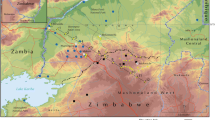Abstract
In large parts sub-Saharan Africa, tsetse flies, the vectors of African human or animal trypanosomiasis, are, or will in the foreseeable future, be confined to protected areas such as game or national parks. Challenge of people and livestock is likely to occur at the game/livestock/people interface of such infested areas. Since tsetse control in protected areas is difficult, management of trypanosomiasis in people and/or livestock requires a good understanding of tsetse population dynamics along such interfaces. The Nkhotakota Game Reserve, an important focus of human trypanosomiasis in Malawi, is a tsetse-infested protected area surrounded by a virtually tsetse-free zone. The abundance of tsetse (Glossina morsitans morsitans) along the interface, within and outside the game reserve, was monitored over 15 months using epsilon traps. A land cover map described the vegetation surrounding the traps. Few flies were captured outside the reserve. Inside, the abundance of tsetse at the interface was low but increased away from the boundary. This uneven distribution of tsetse inside the reserve is attributed to the uneven distribution of wildlife, the main host of tsetse, being concentrated deeper inside the reserve. Challenge of people and livestock at the interface is thus expected to be low, and cases of trypanosomiasis are likely due to people and/or livestock entering the reserve. Effective control of trypanosomiasis in people and livestock could be achieved by increasing the awareness among people of dangers associated with entering the reserve.



Similar content being viewed by others
References
Ford J (1963) The distribution of vectors of African pathogenic trypanosomes. Bulletin WHO 28:653–669.
Hargrove JW, Langley PA (1990) Sterilizing tsetse (Diptera, Glossinidae) in the field—a successful trial. Bulletin of Entomological Research 80:397–403.
JOFCA (1997) Final Report of the Master Plan Study on Sustainable Multiple-use Resource Management of Nkhotakota Wildlife Reserve, Malawi, Tokyo, Japan: Pasco International Inc.
Maudlin I, Holmes PH, Miles MA (2004) The Trypanosomiases, Wallingford, UK: CABI Publishing, 614 p.
Pugh RNH (1987) Resurgence of the tsetse threat in Malawi. Malawi Epidemiology Quarterly 1:6–10.
Simukoko H, Marcotty T, Phiri I, Geysen D, Vercruysse J, Van den Bossche P (2007) The comparative role of cattle, goats and pigs in the epidemiology of livestock trypanosomiasis on the plateau of eastern Zambia. Veterinary Parasitology 147:231–238.
StataCorp (2006) Stata Statistical Software: Release 9.2, College Station, TX: StataCorp.
Swynnerton CFM (1921) An examination of the tsetse problem in North Mossurise, Portuguese East Africa. Bulletin of Entomological Research 11:315–385.
Van den Bossche P (2001) Some general aspects of the distribution and epidemiology of bovine trypanosomosis in southern Africa. International Journal for Parasitology 3:592–598.
Van den Bossche P, De Deken R (2002) Seasonal variations in the distribution and abundance of the tsetse fly, Glossina morsitans morsitans in eastern Zambia. Medical and Veterinary Entomology 16:170–176.
Van den Bossche P, Staak C (1997) The importance of cattle as a food source for Glossina morsitans morsitans Westwood (Diptera: Glossinidae) in Katete District, Eastern Province, Zambia. Acta Tropica 5:105–109.
Van den Bossche P, Esterhuizen J, Nkuna R, Matjila T, Penzhorn BL, Geerts S, et al. (2006) An update of the bovine trypanosomosis situation at the edge of the Hluhluwe-iMfolozi Park, Kwa-Zulu Natal Province, South Africa. Onderstepoort Journal of Veterinary Research 73:77–79.
Van den Bossche P, Shumba W, Makhambera P (2000) The distribution and epidemiology of bovine trypanosomosis in Malawi. Veterinary Parasitology 88:163–176.
Acknowledgments
This study would not have been successful without the support of individuals and institutions—too numerous to be mentioned. Thanks go to the Director and staff of the Department of Animal Health and Industry particularly those at Nkhotakota Rural Development Project for making available the resources needed to conduct the research. Special thanks go to Mr E. Maganga from the Department of Animal Health and Industry for his advice, efforts, and determination during the research. We thank Mr Kalingumbwa of the Nkhotakota Rural Development Project for his advice on the study area, and the farmersof the study area, facilitating the coordination of the research activities. This study was supported financially under the aegis of the Institutional Collaboration Project between the Belgian Development Cooperation and the Department of Veterinary Tropical Diseases of the University of Pretoria (South Africa).
Author information
Authors and Affiliations
Corresponding author
Rights and permissions
About this article
Cite this article
Gondwe, N., Marcotty, T., Vanwambeke, S.O. et al. Distribution and Density of Tsetse Flies (Glossinidae: Diptera) at the Game/People/Livestock Interface of the Nkhotakota Game Reserve Human Sleeping Sickness Focus in Malawi. EcoHealth 6, 260–265 (2009). https://doi.org/10.1007/s10393-009-0252-y
Received:
Revised:
Accepted:
Published:
Issue Date:
DOI: https://doi.org/10.1007/s10393-009-0252-y




